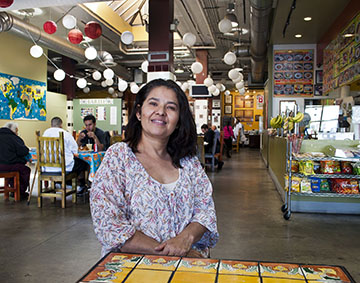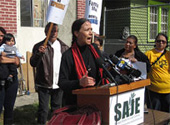
Monic Uriarte, Community Organizer/Health Promoter for Esperanza Community Housing Corporation
Mercado la Paloma promotes a local entrepreneurial spirit while fostering creative and multi-cultural community-based activities and programming.
The conceptual idea of Mercado la Paloma grew in 1999 from local residents living in Esperanza Community Housing Corporation’s building development.
Monic, who has worked in South LA for 16 years, believes Mercado La Paloma “is so important because it gives the opportunity to local residents to dream about being their own business owners. In South Central LA it was almost impossible to get investors to invest in local residents to create local businesses, so Esperanza created Mercado La Paloma to provoke this democratic space.”
Mercado la Paloma promueve un espíritu de comercio local y facilita actividades creativas y multiculturales en la comunidad del Sur de Los Ángeles. La idea del mercado creció en 1999 entre residentes que vivían en un edificio de desarrollo patrocinado por Esperanza Community Housing.









 There’s a house on East Adams Boulevard in South Central Los Angeles where broken windows are covered by cardboard and wrapping paper. Cockroaches crawl in water glasses and a ratty extension cord connecting a generator to a bare fluorescent bulb is stapled to the ceiling.
There’s a house on East Adams Boulevard in South Central Los Angeles where broken windows are covered by cardboard and wrapping paper. Cockroaches crawl in water glasses and a ratty extension cord connecting a generator to a bare fluorescent bulb is stapled to the ceiling.




